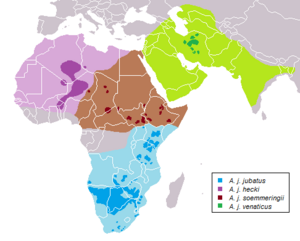Northwest African cheetah facts for kids
Quick facts for kids Northwest African cheetah |
|
|---|---|
| Conservation status | |
| Scientific classification |
|
| Kingdom: | Animalia |
| Phylum: | Chordata |
| Class: | Mammalia |
| Order: | Carnivora |
| Suborder: | Feliformia |
| Family: | Felidae |
| Subfamily: | Felinae |
| Genus: | Acinonyx |
| Species: | |
| Subspecies: |
A. j. hecki
|
| Trinomial name | |
| Acinonyx jubatus hecki Hilzheimer, 1913
|
|
 |
|
| A. j. hecki range historical today | |
| Synonyms | |
|
A. j. senegalensis (Blainville, 1843) |
|
The Northwest African cheetah is also called the Saharan cheetah. It is a special type, or subspecies, of cheetah that lives in the Sahara and Sahel regions of Africa. These cheetahs are in great danger. They are listed as Critically Endangered, meaning they could disappear forever. In 2008, experts thought there were fewer than 250 adult cheetahs left. A German animal expert named Max Hilzheimer first described this cheetah in 1913. He gave it the scientific name Acinonyx jubatus hecki.
About Their Names
Scientists give every animal a special two-part name. This helps everyone around the world know exactly which animal they are talking about. The Northwest African cheetah's scientific name is Acinonyx jubatus hecki.
Another scientist, Henri Marie Ducrotay de Blainville, described a cheetah from Senegal in 1843. He called it Felis jubata senegalensis. Later, scientists realized this was the same type of cheetah as the one Max Hilzheimer described. So, Acinonyx jubatus hecki became the accepted name.
What Do They Look Like?
The Northwest African cheetah looks a bit different from other African cheetahs. Its fur is shorter and almost white. The spots on its back are black, but they fade to light brown on its legs.
Its face has very few spots, or sometimes none at all. The dark lines that usually run from a cheetah's eyes down to its mouth, called "tear stripes," are often missing. This cheetah is also a bit smaller than other cheetahs found in Africa.
Where Do They Live?
These cheetahs live in small, separate groups across the western and central Sahara desert and the Sahel region. From 2007 to 2012, experts estimated there were about 457 cheetahs in West, Central, and North Africa.
Most of these cheetahs live in Central African Republic and Chad (about 238). Others are found in Algeria and Mali (about 191). A smaller group of about 25 lives in a protected area in Benin, Burkina Faso, and Niger.
In Niger, you can find them in the northern Ténéré desert and in the W National Park. Sadly, these cheetahs are thought to be gone from countries like Morocco, Senegal, and Ghana.
In 2010, a camera trap took a picture of a cheetah in Niger's Termit Massif. Between 2008 and 2010, four cheetahs were seen by camera traps in Ahaggar National Park in Algeria. In 2020, another cheetah was filmed in the same park.
How Do They Live?
The Sahara desert is a very tough place to live. Temperatures can go above 40 degrees Celsius (104 degrees Fahrenheit) during the day. Water is hard to find, and it doesn't rain often.
Cheetahs in the Ahaggar mountains have learned special ways to survive this harsh climate. They are mostly active at night, from sunset to early morning. This helps them avoid the extreme heat of the day. They also travel long distances to find food and water.
The main food for Northwest African cheetahs is antelopes that can live in dry places. These include animals like the addax, Dorcas gazelle, and dama gazelle. They also hunt smaller animals like hares. Cheetahs can get all the water they need from the blood of their prey, so they don't always need to find water to drink directly.
See also
- Asiatic cheetah
- Northeast African cheetah


